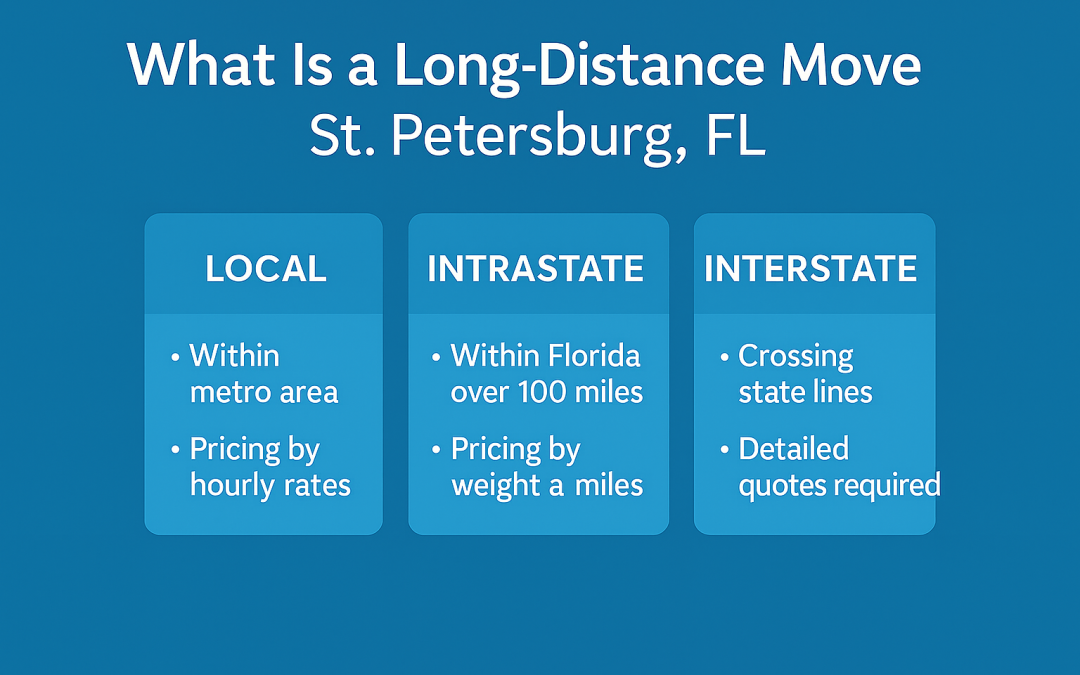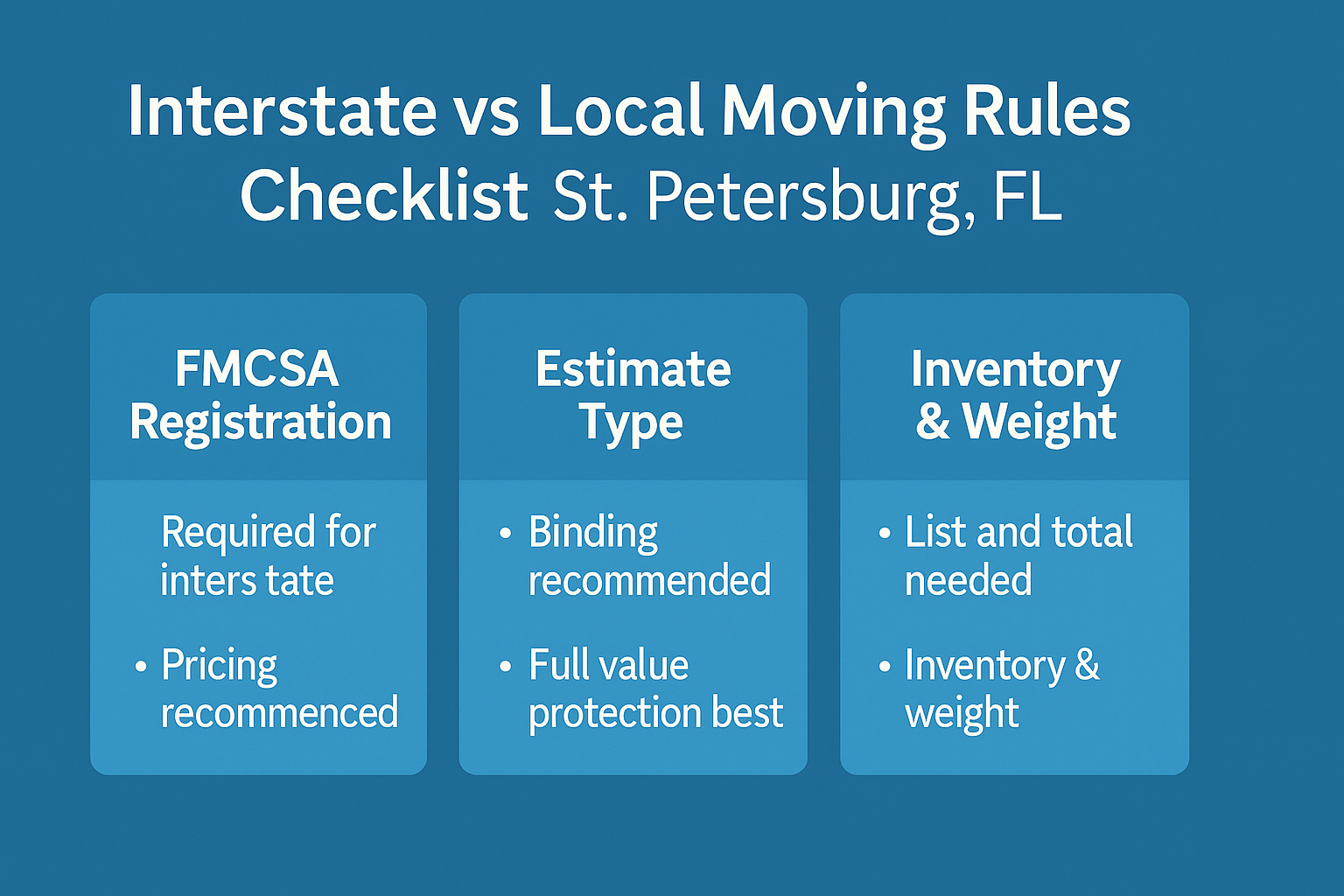Understanding where local ends and long distance begins protects your budget and your rights. This guide clarifies definitions, pricing, and paperwork for St. Petersburg households, with verified sources. For service options and an estimate, visit Karma Movers Long Distance Movers St. Petersburg, FL.
Table of Contents
Crossing state lines, why interstate status matters
A shipment that crosses a state line is an interstate move governed by the Federal Motor Carrier Safety Administration. Interstate household goods carriers must hold active USDOT and MC authority, maintain insurance on file, and follow 49 CFR Part 375 rules for estimates, documents, and delivery. Read FMCSA Protect Your Move and the required Your Rights and Responsibilities When You Move booklet. Verify any mover’s license and insurance using the SAFER Company Snapshot.
Is 100 miles considered long distance
Mileage thresholds vary by context. Some carriers call anything over 100 miles long distance in sales materials. Under federal rules, the label that triggers interstate protection is crossing a state line, not a specific mileage. If your move stays inside Florida but spans many miles, it is intrastate and follows state law, not federal interstate tariff rules.
Does crossing state lines change rules and pricing
Yes. Crossing a state line changes the required licensing, the documents you must receive, and often the pricing method. Interstate moves usually price by actual weight and tariff rates with fuel surcharge. Local moves often price by hourly labor plus materials. Your estimate must state whether it is binding, non binding, or not to exceed. See FMCSA estimate guidance.
How are long distance moves priced vs local
- Interstate pricing. Typically based on surveyed and scale verified weight, distance, and service codes in a carrier tariff. Accessorials like packing, long carry, elevator, shuttle, and storage in transit are added as line items.
- Intrastate or local pricing in Florida. Commonly billed hourly for a truck and crew with materials separate, or by a written estimate that lists flat or capped charges. Florida regulates intrastate movers under Chapter 507, Florida Statutes. Review the state consumer page FDACS Moving Within Florida.
What insurance or valuation applies to interstate vs intrastate
Movers provide valuation coverage, which is not the same as third party insurance. Interstate carriers must offer released value at 60 cents per pound at no extra charge, and full value protection for an additional rate. Details appear on your estimate and bill of lading. Florida intrastate rules require written disclosure of liability terms and options. For interstate definitions, read the FMCSA booklet above and check carrier filings on the FMCSA Licensing and Insurance system.
Do movers charge hourly for long distance
Interstate carriers rarely bill hourly for linehaul. You may see hourly labor for packing on a separate line, but the transport portion is usually weight based with a mileage table. Local and short intrastate moves in Florida more commonly use hourly billing for truck and crew, with a minimum number of hours and travel time. Always ask how packing, materials, and accessorial charges are calculated and listed.
Definitions at a glance, local vs intrastate vs interstate
- Local. Short distance within the same metro, often priced hourly. Paperwork is simpler, but you still deserve a written estimate and invoice.
- Intrastate. Within Florida state lines, subject to Chapter 507 and FDACS rules for advertising, contracts, and penalties.
- Interstate. Crosses a state line, subject to FMCSA, USDOT safety rules, and federal consumer protections for estimates, delivery, and claims.
Paperwork you should receive and what each document does
- Written estimate indicating binding, non binding, or not to exceed, with inventory or cube sheet.
- Order for service and bill of lading that lists pickup and delivery spreads, valuation option, and payment terms.
- Inventory with unique tag numbers, piece count, and condition notations.
- Weight tickets for interstate shipments that price by weight.
- Claims instructions and deadlines per federal or state rules.
How to verify a mover before you sign
- Search the SAFER Company Snapshot for USDOT and MC status, operating authority, and insurance on file.
- Confirm complaint history and enforcement using FMCSA Protect Your Move.
- For Florida intrastate work, check the FDACS database and consumer guidance and request the mover’s registration details.
- Ask for a copy of the signed estimate and inventory, and verify the estimate type.
- Read the federal booklet Your Rights and Responsibilities When You Move and keep it with your moving binder.
Examples and edge cases that confuse buyers
- Apartment to storage across the bay. If both addresses are in Florida, this is intrastate even if you cross a body of water.
- St. Petersburg to Savannah with a same day stop in Jacksonville. Interstate, because the final destination is Georgia.
- House to temporary housing in Tampa with later shipment to North Carolina. The second leg is interstate and requires federal paperwork.
- Partial do it yourself with a container. If the container crosses state lines, interstate rules apply to that portion, even if local labor handles loading.
Practical checklist for St. Petersburg households
- Book surveys 8 to 12 weeks before summer dates, earlier for 3 bedroom and larger homes.
- Reserve elevators and loading zones in Downtown, Old Northeast, Historic Kenwood, and Edge District.
- Ask if a shuttle is required in Snell Isle, Crescent Lake, or Coquina Key where tractor access is tight.
- Photograph high value items before packing and note existing wear.
- Stage a do not pack zone for medications, documents, and keys.
- Confirm whether your move is intrastate or interstate and match the paperwork and pricing method to that status.
FAQs woven into headings, quick answers
Is 100 miles considered long distance
Some carriers use 100 miles for marketing, but federal consumer protections hinge on crossing state lines. Inside Florida, state rules apply regardless of miles.
Does crossing state lines change rules
Yes, interstate rules require USDOT and MC authority, federal estimate types, and specific rights documents. Pricing usually shifts to weight based tariffs.
How are long distance moves priced vs local
Interstate is weight and distance with tariff line items. Local is usually hourly labor with materials, travel time, and minimum hours. Intrastate can use either.
What insurance applies to interstate moves
Valuation options are disclosed on the estimate and bill of lading. Released value is minimal, full value protection costs more but covers repair or replacement.
Do movers charge hourly for long distance
Rarely for linehaul. Expect hourly only for packing or special services. Transport charges use tariff rates tied to weight and miles.
Get clear on your move type, then lock in the correct estimate and timeline. Request a survey and written estimate from Karma Movers Long Distance Movers St. Petersburg, FL and confirm your paperwork.
- Contact Karma Movers, quotes and booking, Contact us.
- Local movers page for short moves and staging, Local Movers St. Petersburg.
- City resources to plan parking and timing: City of St. Petersburg, Pinellas County, Tampa, Clearwater, Largo.
- Neighborhoods we often serve: Old Northeast, Historic Kenwood, Snell Isle, Crescent Lake, Pasadena, Coquina Key.
Authority resources referenced: FMCSA Protect Your Move, Your Rights and Responsibilities When You Move, SAFER Company Snapshot, FDACS Moving Within Florida, FMCSA Licensing and Insurance.


